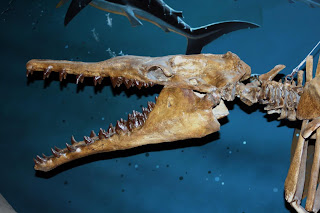A beautiful mount of a sailfish (Istiophorus) in the new Sant Ocean Hall.
A sculpture of a northern right whale (Eubalaena japonica) in the Sant Ocean Hall.
A familiar face! This is a cast of the skull of the early toothed mysticete Llanocetus denticrenatus from the latest Eocene of Seymour Island, Antarctica. The skull was collected by Ewan Fordyce in Summer 1986 on an antarctic expedition. We have the original (and a cast) here in our department, currently under study by Ewan.
The holotype mandibular fragment of Llanocetus denticrenatus, collected on an earlier expedition and named by Ed Mitchell in 1989.
A mounted cast of the skeleton of the Egyptian basilosaurid archaeocete Dorudon atrox.
A mounted skeleton of the Eocene protocetid archaeocete Maiacetus inuus from Pakistan. This is a cast of the male individual; the female - the "Good Mother Whale" - was found with the skeleton of a near term fetus inside.
A giant or Japanese spider crab, Macrocheira kaempferi, in the Sant Ocean Hall - nightmare fuel for my wife.
Dolly! Or, Dolichorhynchops as she's known to the marine reptile community. A 3-4 meter long short necked pliosaur.
Skeleton of the basilosaurid Zygorhiza from the Eocene of the southeastern US. It's about a 5 meter long animal with pretty gnarly teeth (as with all basilosaurids).
And here's the skull of Zygorhiza. It retains some primitive features, such as teeth below the orbit and heterodonty (teeth of different morphologies such as incisors, molars, etc), and several adcanced features like a posteriorly shifted bony naris and reduced hindlimbs.
The paratype skull of Diorocetus hiatus, described by Remington Kellogg in the 1960's, from the Calvert Formation of Maryland. I saw the holotype, and as mentioned in a previous post, parts of it are mostly sculpted.
Mounted skeleton of the strange Miocene pinniped Acrophoca longirostris from Peru. This long-snouted seal is well known from the Pisco Formation, and has something to do with the evolution of modern antarctic lobodontine seals.
An undescribed species of Spheniscus penguin, also from the Pisco Formation of Peru.
An early type of different flightless bird - a cast of Hesperornis, a very well known toothed swimming bird from the "middle" Cretaceous of North America, first described by O.C. Marsh from the Niobrara Formation.
Some pretty pencil urchin.
A preserved adult and juvenile coelacanth (Latimeria), a living fossil. For the uninitiated - coelacanths were known from the fossil record (Triassic, Jurassic, and Cretaceous), but thought to have gone extinct at the K/Pg boundary along with nonavian dinosaurs and other groups (e.g. ammonites, mosasaurs); a live specimen was caught off South Africa in the 1930's.

















No comments:
Post a Comment